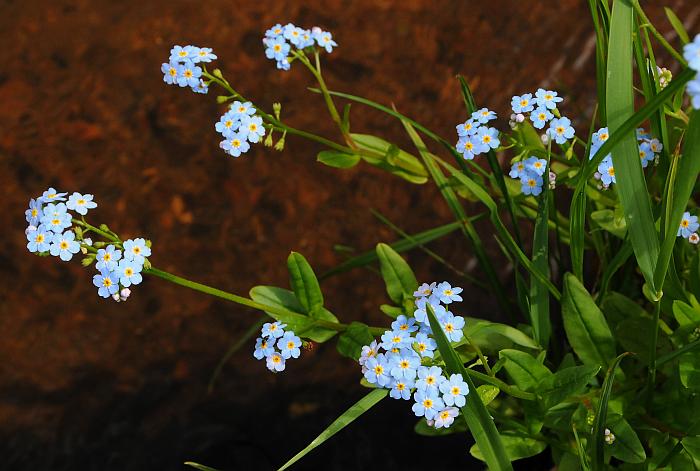Myosotis scorpioides L.
Forget-Me-Not

Introduced
CC = *
CW = -5
MOC = 6
© SRTurner
Myosotis scorpioides L.Forget-Me-Not | |
 |
Introduced CC = * CW = -5 MOC = 6 |
© SRTurner |
|
Family - Boraginaceae Habit - Fibrous-rooted perennial. Stems - Lax, spreading, with ascending tips, rooting at lower nodes, usually branched, pubescent with antrorse hairs.
Leaves - Alternate, simple, entire, to 8 cm long, oblong or oblanceolate, sessile, rounded at tip, pubescent with appressed hairs.
Inflorescences - Racemes or small panicles, sometimes paired at the branch tips, the spikelike the flowers with stalks 3-5 mm long, these elongating to 5-8 mm and spreading to slightly drooping at fruiting, all or nearly all lacking bracts.
Calyces - 2.5-4.0 mm long, actinomorphic, 5-lobed less than 1/2 of the way to the base, the lobes all similar in appearance, broadly triangular, moderately to densely pubescent with short, appressed hairs.
Corollas - Corollas 4-10 mm long, saucer-shaped, the tube 2.0-3.5 mm long, the spreading portion 5-9 mm in diameter, light blue with a yellow spot in the throat, usually pink in bud. Stamens inserted near the tip of the corolla tube. Pistil 1 per flower, with 2 fused carpels. Style 2.0-2.5 mm long, equal to or extending slightly beyond the tips of the nutlets.
Fruits - Schizocarps splitting into 4 nutlets, these 1-2 mm long, dark brown or black. Flowering - April - October. Habitat - Spring branches, streambanks, lake margins. Also cultivated. Origin - Native to Europe. Lookalikes - Myosotis stricta. Other info. - This delicate and pretty species is uncommon in Missouri, being found sporadically in wet places. It is much more common in the upper Midwest, Northeast, and Northwest. Flowering plants are easily identified by their relatively showy panicles of small, sky-blue flowers. The species is distinguished from the lookalike M. stricta by the size of the flowers, which in the latter species are very small (<3 mm diameter). Other lookalikes do exist, but none are found in Missouri's wilds. M. scorpioides is garden favorite and is nonaggressive, rarely escaping cultivation in the Midwest. Photographs taken at Onondaga Cave State Park, Crawford County, MO, 8-20-2014, and in Estes Park, CO, 6-19-2018 (SRTurner). |